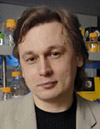 Ruma Banerjee, Ph.D. is the Vincent Massey Collegiate Professor of Biological Chemistry at the University of Michigan. Her laboratory studies the coordinate regulation of methylation and redox homeostasis at the organismal, cellular, molecular and computational levels to elucidate key switchpoints and the traffic lights that regulate this metabolic nexus. Dr. Banerjee's lab also studies the gene-nutrient interactions that influence flux of sulfur metabolites by virtue of the B-vitamin dependence of several pathway enzymes. In addition, her lab is studying the co-dependence of cell types for their energy and redox metabolic needs. Specifically, her lab is interested in the mechanism of autoimmunity by which regulatory T cells can suppress the proliferation and clonal expansion of effector T cells following activation by antigen presenting cells such as dendritic cells. Dr. Banerjee is also interested in how biology exploits the reactivity of radicals on the one hand while containing it on the other to turnover substrates to products with high fidelity. Her lab uses a variety of biophysical (EPR spectroscopy, stopped-flow kinetics) approaches together with biochemical analysis of patient mutations to elucidate the mechanisms of these clinically important enzymes and understand the biochemical basis of metabolic defects caused by their impairments.
Ruma Banerjee, Ph.D. is the Vincent Massey Collegiate Professor of Biological Chemistry at the University of Michigan. Her laboratory studies the coordinate regulation of methylation and redox homeostasis at the organismal, cellular, molecular and computational levels to elucidate key switchpoints and the traffic lights that regulate this metabolic nexus. Dr. Banerjee's lab also studies the gene-nutrient interactions that influence flux of sulfur metabolites by virtue of the B-vitamin dependence of several pathway enzymes. In addition, her lab is studying the co-dependence of cell types for their energy and redox metabolic needs. Specifically, her lab is interested in the mechanism of autoimmunity by which regulatory T cells can suppress the proliferation and clonal expansion of effector T cells following activation by antigen presenting cells such as dendritic cells. Dr. Banerjee is also interested in how biology exploits the reactivity of radicals on the one hand while containing it on the other to turnover substrates to products with high fidelity. Her lab uses a variety of biophysical (EPR spectroscopy, stopped-flow kinetics) approaches together with biochemical analysis of patient mutations to elucidate the mechanisms of these clinically important enzymes and understand the biochemical basis of metabolic defects caused by their impairments.
Website: http://medicine.umich.edu/dept/biochem/ruma-banerjee-phd
 Vadim Gladyshev, Ph.D. is a Professor with the Department of Medicine at Harvard Medical School and Director of Redox Medicine at Brigham and Women's Hospital. His laboratory is working to understand mechanisms of redox regulation of cellular processes. Little is known what specific targets of reactive oxygen species are and how oxidant and antioxidant signals are transmitted and regulated in the cell. To understand redox regulation, it is important to know identities and functions of participants in the redox processes. Dr. Gladyshev's laboratory focuses on thiol oxidoreductase functions, their targets and roles in disease. His lab develops and employs various high-throughput approaches that take advantage of genome sequencing, proteomics, bioinformatics and functional genomics methods, and which are followed with in vitro and in vivo studies. One of Dr. Glaydshev's projects focuses on the functions of the mammalian selenoproteome. Another project involves functional characterization of thioredoxin reductases (TRs). His laboratory also focuses on the methionine sulfoxide reductase system and its role in aging. It is hoped that their studies will provide a better understanding of the role of redox processes and trace elements in physiological and pathophysiological states, particularly in regard to cancer, aging and male reproduction, and will lead to new therapeutic and disease-preventive agents.
Vadim Gladyshev, Ph.D. is a Professor with the Department of Medicine at Harvard Medical School and Director of Redox Medicine at Brigham and Women's Hospital. His laboratory is working to understand mechanisms of redox regulation of cellular processes. Little is known what specific targets of reactive oxygen species are and how oxidant and antioxidant signals are transmitted and regulated in the cell. To understand redox regulation, it is important to know identities and functions of participants in the redox processes. Dr. Gladyshev's laboratory focuses on thiol oxidoreductase functions, their targets and roles in disease. His lab develops and employs various high-throughput approaches that take advantage of genome sequencing, proteomics, bioinformatics and functional genomics methods, and which are followed with in vitro and in vivo studies. One of Dr. Glaydshev's projects focuses on the functions of the mammalian selenoproteome. Another project involves functional characterization of thioredoxin reductases (TRs). His laboratory also focuses on the methionine sulfoxide reductase system and its role in aging. It is hoped that their studies will provide a better understanding of the role of redox processes and trace elements in physiological and pathophysiological states, particularly in regard to cancer, aging and male reproduction, and will lead to new therapeutic and disease-preventive agents.
Website: http://gladyshevlab.bwh.harvard.edu/
 Leslie B. Poole, Ph.D. is a Professor of Biochemistry at Wake Forest School of Medicine. Organisms living in aerobic environments require mechanisms which prevent or limit damage to cellular components by reactive oxygen species; these species arise from the incomplete reduction of oxygen during respiration or from exposure to external agents such as light, radiation, redox-cycling drugs or stimulated host phagocytes. A variety of enzymatic and nonenzymatic systems have evolved within living organisms to counter such damage. In bacteria such as Salmonella typhimurium and Escherichia coli, expression of a set of antioxidant enzymes is controlled in a coordinate fashion by an oxidation- reduction-sensitive regulatory protein, OxyR. Using a high-expression OxyR mutant of S. typhimurium, a novel enzymatic activity responsible for the NAD(P)H-linked reduction of toxic organic hydroperoxides was discovered. This alkyl hydroperoxide reductase (AhpR), which is the focus of studies in Dr. Poole's laboratory, was subsequently shown to be separable into two protein components, designated AhpF and AhpC. AhpF is an FAD-containing protein related to another well- characterized flavoprotein, thioredoxin reductase, and catalyzes the transfer of electrons from NAD(P)H to AhpC. The smaller AhpC protein is without a chromaphoric cofactor and serves directly as the peroxide-reducing component (homologues of AhpC are widespread in biological systems and have been designated "peroxiredoxins"). Her lab's studies of the catalytic mechanism of AhpR indicate that both component proteins operate through cycling of protein- derived cystine disulfides between oxidized (disulfide) and reduced (dithiol) states. Anaerobic titrations of each protein with reductants have confirmed the presence and essentiality of three redox centers in AhpF (one FAD and two disulfide centers) and one redox-active disulfide center per monomer in AhpC (Poole, 1996; Poole, Godzik, et al, 2000). Her lab has also shown that an unusual oxidized cysteine derivative, cysteine-sulfenic acid (Cys-SOH), is generated transiently through direct oxidation of Cys46, one of the two cysteine residues of AhpC, by the hydroperoxide substrate (Ellis & Poole, 1997a & b). Related oxidized cysteine derivatives have been identified in the two other known heme- and metal-independent peroxide reductases (NADH peroxidase and glutathione peroxidases) and may play a role in signal transduction by the OxyR protein itself.
Leslie B. Poole, Ph.D. is a Professor of Biochemistry at Wake Forest School of Medicine. Organisms living in aerobic environments require mechanisms which prevent or limit damage to cellular components by reactive oxygen species; these species arise from the incomplete reduction of oxygen during respiration or from exposure to external agents such as light, radiation, redox-cycling drugs or stimulated host phagocytes. A variety of enzymatic and nonenzymatic systems have evolved within living organisms to counter such damage. In bacteria such as Salmonella typhimurium and Escherichia coli, expression of a set of antioxidant enzymes is controlled in a coordinate fashion by an oxidation- reduction-sensitive regulatory protein, OxyR. Using a high-expression OxyR mutant of S. typhimurium, a novel enzymatic activity responsible for the NAD(P)H-linked reduction of toxic organic hydroperoxides was discovered. This alkyl hydroperoxide reductase (AhpR), which is the focus of studies in Dr. Poole's laboratory, was subsequently shown to be separable into two protein components, designated AhpF and AhpC. AhpF is an FAD-containing protein related to another well- characterized flavoprotein, thioredoxin reductase, and catalyzes the transfer of electrons from NAD(P)H to AhpC. The smaller AhpC protein is without a chromaphoric cofactor and serves directly as the peroxide-reducing component (homologues of AhpC are widespread in biological systems and have been designated "peroxiredoxins"). Her lab's studies of the catalytic mechanism of AhpR indicate that both component proteins operate through cycling of protein- derived cystine disulfides between oxidized (disulfide) and reduced (dithiol) states. Anaerobic titrations of each protein with reductants have confirmed the presence and essentiality of three redox centers in AhpF (one FAD and two disulfide centers) and one redox-active disulfide center per monomer in AhpC (Poole, 1996; Poole, Godzik, et al, 2000). Her lab has also shown that an unusual oxidized cysteine derivative, cysteine-sulfenic acid (Cys-SOH), is generated transiently through direct oxidation of Cys46, one of the two cysteine residues of AhpC, by the hydroperoxide substrate (Ellis & Poole, 1997a & b). Related oxidized cysteine derivatives have been identified in the two other known heme- and metal-independent peroxide reductases (NADH peroxidase and glutathione peroxidases) and may play a role in signal transduction by the OxyR protein itself.
Website: https://school.wakehealth.edu/faculty/p/leslie-b-poole
 Nick Tonks, Ph.D. is a Professor at the Cold Spring Harbor Laboratories. Areas of research in Dr. Tonks' lab include functional analysis of members of the PTP family, using RNA interference in cell and animal models of disease. This is integrated with development of novel approaches to therapeutic intervention in PTP function. Cells respond to environmental stimuli by initiating integrated networks of signal transduction pathways that are governed by reversible protein phosphorylation. Dr. Tonks' laboratoy focuses on protein tyrosine phosphorylation, aberrant regulation of which has been shown to underlie the etiology of major human diseases. His laboratory studies this from the perspective of characterizing the structure, regulation and function of the Protein Tyrosine Phosphatase (PTP) family of enzymes. Overall, the objective of the lab is to develop strategies and tools for analysis of PTP regulation and function and integrate them with state of the art cell and animal models, to define critical tyrosine phosphorylation-dependent signaling events in human disease and thereby identify novel therapeutic targets.
Nick Tonks, Ph.D. is a Professor at the Cold Spring Harbor Laboratories. Areas of research in Dr. Tonks' lab include functional analysis of members of the PTP family, using RNA interference in cell and animal models of disease. This is integrated with development of novel approaches to therapeutic intervention in PTP function. Cells respond to environmental stimuli by initiating integrated networks of signal transduction pathways that are governed by reversible protein phosphorylation. Dr. Tonks' laboratoy focuses on protein tyrosine phosphorylation, aberrant regulation of which has been shown to underlie the etiology of major human diseases. His laboratory studies this from the perspective of characterizing the structure, regulation and function of the Protein Tyrosine Phosphatase (PTP) family of enzymes. Overall, the objective of the lab is to develop strategies and tools for analysis of PTP regulation and function and integrate them with state of the art cell and animal models, to define critical tyrosine phosphorylation-dependent signaling events in human disease and thereby identify novel therapeutic targets.
A major emphasis involves characterization of the regulation of PTP function by reversible oxidation. Hydrogen peroxide, produced in response to a wide variety of physiological stimuli, fine-tunes tyrosine phosphorylation-dependent signaling by transient oxidation and inactivation of those PTPs that normally down-regulate the signaling response. We are exploiting redox regulation to establish functional links between individual PTPs and the control of specific signaling pathways and to modify the cellular response to such pathways.
Finally, Dr. Tonks' laboratory is characterizing a knockout mouse model to define the function of JSP1, a member of the PTP family that is a novel regulator of MAP kinase signaling.
Website: https://www.cshl.edu/research/faculty-staff/nicholas-tonks/